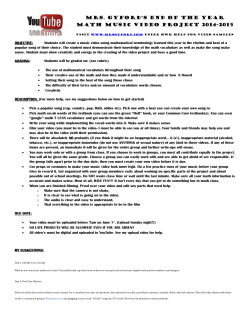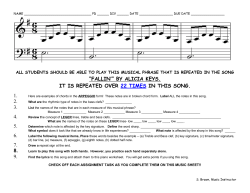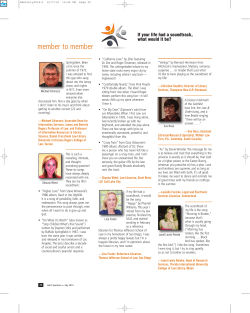
...I've Got Music “I ” don’t know anything
...I've Got Music Youth Culture “I don’t know anything about music. In my line you don’t have to.” In 1956 Billboard Magazine had one chart for all pop music. Today, it has 175. Hip Hop, Bubblegum, Emo, Grunge, Garage, Gothic, Rap, Punk, Disco – the list goes on. The music genres of today's youth are numerous, fluid and overlapping. Here are the five main genres and some of their sub-genres. ~ Elvis Presley Country – The twang genre is now popular in certain teenage circles. Artists such as Kenny Chesney, Sugarland, Rascal Flatts, and Taylor Swift are teen mainstream. Within Country music you will find rock, blues, and gospel influences. Pop – The primary objectives of pop are not form or beauty but audience enjoyment and commercial success. Pop is the broadest youth music genre. Its characteristics are difficult to pinpoint because it borrows from most other genres. Notable pop artists are Britney Spears, Rihanna, Christina Aguilera and most American Idol winners. The music tends to be upbeat, vocally driven and dominated by female artists. Rock – In its purest form the second largest genre has three chords, a strong, insistent back beat and a catchy melody. Core instruments are the guitar, bass and drums. Rock music can be plotted on certain scales. One fits songs on the soft rock to hard rock continuum (from Pop to Heavy Metal). Another scale is from Indie to Alternative to Mainstream. Punk, Garage , Emo, Grunge, Britpop are examples of music that started Indie, became Alternative and then almost Mainstream. VOCABULARY Indie: music produced independently from a record company. (Where new sub-genres begin.) Bling: jewelry, especially gold and diamonds. Hoodie: a hooded sweatshirt. 2008 north america ISSUE 12 November newsletter Electronic/Dance – The music genre most prevalent at clubs. It is created solely through digital technology not instruments. It has a thumping beat and repeat sequences. It is less popular now than during the rave era of the 1990’s but continues on as a huge part of the nightlife and dance scene. - Oki Varona The pose and the attitude of Hip Hop. Missing: The Bling and the Hoodie Rhythm and Blues – R&B originally referred simply to music from the Black community. Soul, Funk and Mo-town were popular sub-genres. Currently, the most popular sub-genre is Rap. Within Rap, Hip Hop tops the charts. The Gangsta Rap of the 1990s (Ice-T, Tupac, LL Cool J, Eminem) was openly violent and anti-establishment. Today’s Hip Hop artists (Jay Z, Lil Wayne) focus their lyrics on money, sex, power and fame. Songs by the artists T-Pain and Ne-Yo are the most popular selections for club deejays. “We don't like their sound, and guitar music is on the way out.” ~ Decca Recording Co. (rejecting the Beatles in 1962) TOUGH TRUTH The next page looks at two recent NUMBER ONE songs – the most played, heard and seen among teens. The lyrics and pictures have been edited to remove the most explicit details. Your children get them unedited. LIL WAYNE He's not just a scary looking guy with no shirt and his entire butt hanging out of his pants. He is MTV’s most popular singer. This week he has five songs in Billboard’s top 50 at #18, #21, #23, #28 and #40. His song, “Lollipop”, was on the chart for 28 weeks and #1 for over a month. Here are some of the lyrics (edited): Man, she ain't never had a love like mine And man I ain't never seen an (bleep) like hers And that (bleep) in my mouth had me loss for words Told her back it up like erp erp And I made that (bleep) jump, like jerk, jerk And that's when she lick me like a (song title). This photo from a live concert has been cropped due to obscenity. Lil Wayne has been arrested several times, most recently in January when police found 105 grams of marijuana, 29 grams of cocaine and 41 grams of ecstasy in his car. BRITNEY SPEARS On September 26th Britney Spears released “ Womanizer”, a song about refusing to be seduced by a man. Critics panned the lyrics and melody. The song sat at 96th on the pop chart. On October th 10 the news program 20/20 showed the music video for the tune. The song shot to #1 in four days, the fastest chart-climb ever. What explains the meteoric rise? The video is soft porn. As the #1 song it will get airplay time, be talked about and get downloaded. It will be seen on iPods, cable TV, computers, and cell phones. It will be downloaded from MTV, YouTube and iTunes . Kids will watch it on the bus, on playgrounds, at friend's houses and at work. It is not flagged as offensive by MTV, iTunes, YouTube or Covenant Eyes. The best software for cases like this is Spector Pro, but even that wont protect your children on the playground. Only the right inner res olve about what they allow themselves to hear and see will spare them. Next month we will examine what you can do to help them. Not Just an Option The immediate need for an alternative youth culture is evident. It is not just an option. It is critical. Parents and youth workers must envision and radicalize youth to live at odds with the prevailing culture. But it is very difficult for youth to be strong on their own. They (like adults) need the help of others in the body of Christ. An alternative youth culture can only be sustained by a group of communities, churches, parents and youth workers together – and not just for a few years but over decades and generations. They must build a bulwark to defend the weak and helpless. They will need to be a company of saints, missionaries and martyrs who witness to hope in an increasingly lost and hopeless world. Part of that hope is knowing that it is not to late. ➢“Wom anizer” was down- loaded 285,000 times in four days, following its premier in the USA. That is on e download for every 1,000 Americans. Not many were aged over fifty or under seven. ➢86% of teens believe that music piracy is not wrong. ➢73% of Ch ristian youth say they aren't affected by th e lyrics of a song. ➢U.S. music sales: Pop/Rock = 79% Country = 10% Christian = 6% Jazz, Classical... = 5% ➢90% of parents say th ey have had a conversation with their teens about delaying sex and avoiding pregnancy. 71% of their teens agree it happened. ➢88% of all children lived with two parents in 1960. In 2007, 68% did. ➢5% of all children born in 1960 were to unmarried mothers. Th at figure ros e to 38.5% in 2006. Contact us: kairos.editor@gmail.com
© Copyright 2025





















